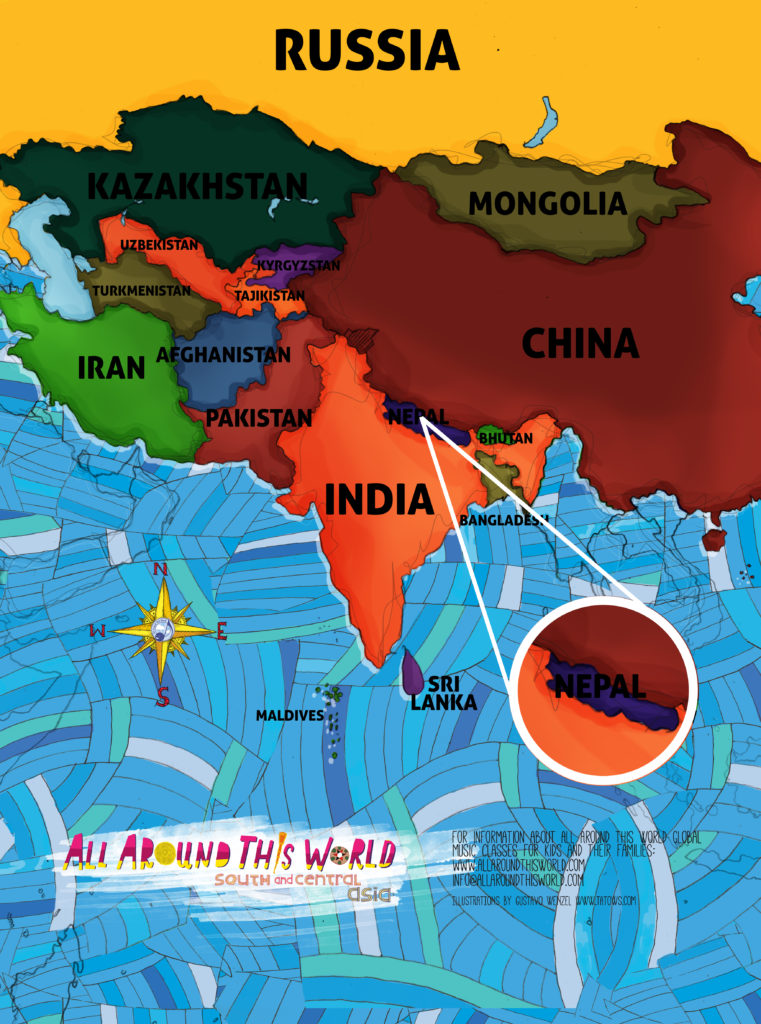In our online class this week we sing “Khaunla Pataima,” our version of a contemporary Nepali song about desperately wanting to be with someone you love. You can hear an original version on the Smithsonian Folkways recording “Songs and Dances of Nepal.” The liner notes grant us this fine summary: “The boy wishes to go everywhere with the girl. He says to her: ‘We will eat from the same plate. sit in the same place. and go in the same places.’ Hence, the lyrics of the All Around This World version: “Khaunla pataima, khaunla pataima, Everywhere, everywhere, everywhere, everywhere, Khaunla pataima. I want to go with you, I want to go with you, everywhere everywhere everywhere everywhere.”
Tag Archives | Nepal
The Hippie Trail
Going to Nepal? Let’s hop onto the “Hippie Trail.”
Nepal wasn’t a very popular travel destination for Westerners until the 1960s, when Katmandu became an endpoint on “the Hippie Trail,” the fabled road that took hippies on an overland path from London across Europe through Istanbul, Terhan, Herat, Peshawar, through India and eventually up into the Himalayan heavens. Today’s Nepal is still a popular destination for trekkers, mountain climbers, spiritual explorers, cosmic partiers (like those attending the Shakti Peak Festival) and yes, even HIPPIES (a la “Freak Street.”) It is also a destination of bloggers; travelers who visit Nepal want to relay their adventures and, most of all, share what they learned with others.
Kutumba has a LOT of friends
Let’s start our musical time in Nepal by visiting our new favorite Nepali band, Kutumba, and 400 of their friends.
Today’s Nepali music scene is a mix of traditional music and “imported music,” like Nepali pop and rock (watch even muore Kutumba), Nepalese simultaneously credit and blame the hippies with introducing Western music via Katmandu’s Freak Street. What, pray tell, is Freak Street? Stay tuned and we’ll tell ya.
New to Nepal? Not anymore.
This week’s online class for kids takes us to Nepal, a place many Westerners know as home to Sagarmatha (okay, we know it as Mt. Everest) and sure-footed Sherpas. Do we consider the country a refuge of freaky hippies or a haven for budget-travelers? How about as place to go to cleanse the soul?
Nepal is all of those things, but it’s also a linguistically and ethnically complicated nation, undergoing historic political change while facing the challenge of substantial poverty. It’s also a deeply spiritual land — both the birthplace of Buddha and the only officially Hindu nation in the world…at least until 2006 when, facing political pressure, the country formally became secular.
“Top of the World, Ma!” — Climb Everest with your Kids
Obviously, the best way to end our week of explorations in Nepal is to climb Everest with our children. How do we do this…other than CAREFULLY?
Well, after introducing Nepal and Mt. Everest to our children, we imagine a triumphant climb in seven short steps:
1. Collect our climbing gear, meet a Sherpa guide, and a yak
2. Start with a 6-8 day trek from Lukla to Base Camp at 17, 600 feet.
3. Scale the Khumba Icevall and sleep at Camp 1
4. Go through the Valley of Silence (a glacial valley with little wind)
5. Sleep at Camp 2, Go through unfortunately-named “Death Zone” to Camp 3. (You can tell your kids about “Death Zone” or leave that one out.)
6. Summit! Start at midnight, rest on “The Balcony” and see the sun rise, summit is 28,700 feet.
7. Climb down in reverse. Go home and brag to all your friends.
8. Wake up the next day and climbu Everest again.
Climb Every Mountain
Mt. Everest, known in Nepal as Sagarmatha, meaning, roughly, “Goddess of the Sky,” and to Tibetans as Chomolungma, “Goddess Mother of the Land,” is the tallest mountain in the world.
Every year hundreds of mountaineers from around the world attempt to reach the 29,029 foot high summit, enlisting Nepali Sherpa people to help them climb. In our online class we’re going to teach kids how to climb Everest — Sagarmatha! — using our imaginations. That means we can climb without Sherpas and yaks…or, with a hundred Sherpas and a million yaks.
In Nepal: How to to Say No to Momo
Nepali is the most widely spoken of the approximately 120 languages of Nepal. If you find yourself trapped in Nepal and you have to charm your way out by demonstrating your mastery of the Nepali, use some of these phrases. (If you’re vegetarian and someone offers you a plate of momo, use these).


